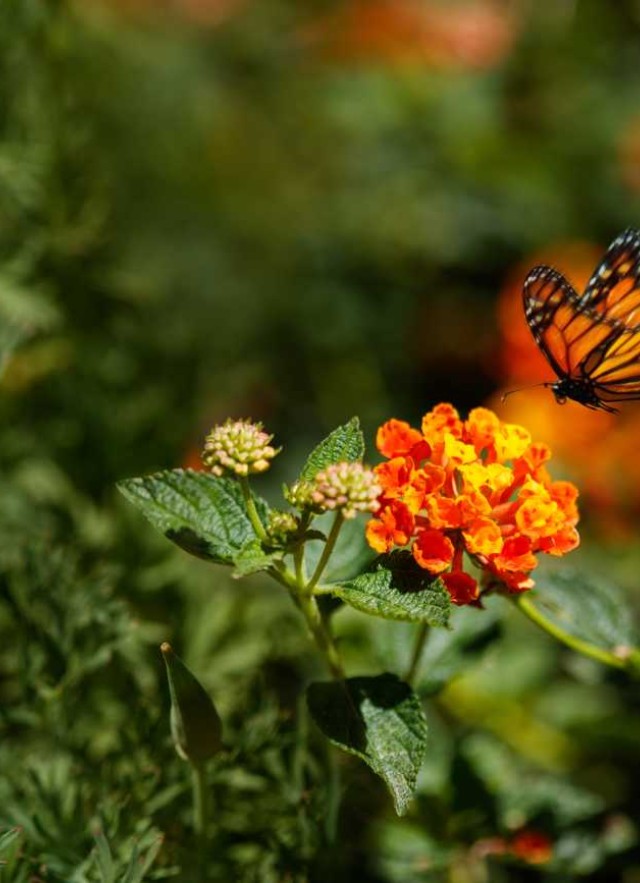
Originally published May 20, 2015
Co-Authored by Lila Higgins and Miguel Ordeñana
Somewhere in L.A. a monarch egg hatched and out popped a tiny girl caterpillar. That caterpillar ate, and ate, and ate. She ate milkweed, the only plant she could, until she molted her skin. All told, she molted four times until she was a big, fat, stripy caterpillar with black tentacles. She made one last molt and formed a bright green chrysalis with shining golden spots. Two weeks later she emerged from that chrysalis as an adult, and then she flew. On November 17, 2014 she was spotted in the Museum’s Nature Gardens. She was caught in a net, and gently removed by skilled hands. A small, circular, paper sticker was affixed to her hind wing with the numbers 64365 printed on it. She was released and flew off into the distance. We knew there was a good chance that we’d never see her again.

If you’ve roamed our Nature Gardens over the past few months you may have noticed tags on our monarch butterflies (Danaus plexippus). No, these aren’t fashion accessories like dog outfits—they’re actually a citizen science tool for tracking monarch movements. The small paper stickers are like a butterfly license plate and allow us to find out where the monarch butterflies in our garden are going. Very little is known about monarch populations of Los Angeles and urban areas in general. It is pretty well known that some monarch butterfly populations migrate—we’ve all heard of the monarchs east of the Rockies that fly thousands of miles down to central Mexico to overwinter. Monarch populations west of the Rockies overwinter along the California coast between Sonoma and Baja. But, our L.A. monarchs are a bit of a mystery, it is not clear which migration path our monarchs follow, or if they migrate at all. Our tagging efforts in the Nature Gardens are part of the Southwest Monarch Study, a group dedicated to identifying and describing the migration and breeding patterns of monarch butterflies in the Western United States, and promoting monarch butterfly conservation.
We began tagging last fall in October, during one of our citizen science programs. Forty-four intrepid citizen scientists were trained how to safely capture, handle, and tag monarchs. That day we managed to tag 16 butterflies, and participants took extra tags home to continue the effort in their own neighborhoods. But, we still had a lot of tags left, and didn’t want to send them back.

We came up with an idea that would bring citizen science to our visitors! During our afternoon nature walks in the gardens, visitors learned how to tag monarchs with our staff. We showed them how to catch the butterflies, how to affix the tiny sticker, and how to record the data. Between October 2014 and March 2015 our visitors tagged over a 100 monarch butterflies. Of the 102 butterflies tagged, 33 were recaptured in the gardens including one that was caught two months and 24 days later. Then, on December 27, Donna N., a local Angeleno, found a butterfly on her car in Boyle Heights. She noticed the small sticker and called the phone number on it. She reported the finding and became LA’s newest citizen scientist. Turns out this butterfly was our female, monarch 64365! Although, her seven mile trip isn’t as harrowing as that of P-22, the famous Griffith Park mountain lion that crossed the 405 and 101 freeways, our little monarch had to fly over the 110 freeway. We’ll never know her exact route, or where she went in those intervening 30 days. But, we can hope she found some milkweeds and laid some eggs along the way.
The need to put monarchs on everyone’s radar is especially relevant now as they are currently under review by the U.S. Fish and Wildlife Service to be listed as “Threatened” under the Endangered Species Act. Although the season for tagging monarchs is over for the year, our effort to better understand and protect them is not. Our Monarch Waystation (next to the Butterfly Pavilion) recently opened for the year, our garden volunteers are continuing to care for the over 500 nectar and milkweed plants that monarchs rely on in our gardens, and we'll be tagging monarchs again in the fall. Ultimately all these efforts help to ensure that the children, grandchildren, and great-grandchildren of monarch 64365 have a place to thrive in Los Angeles. **If you want to help us protect our L.A. monarchs send an e-mail to nature@nhm.org. We’ll send you details on the monarch citizen science/volunteer opportunities and programs you can sign up for.